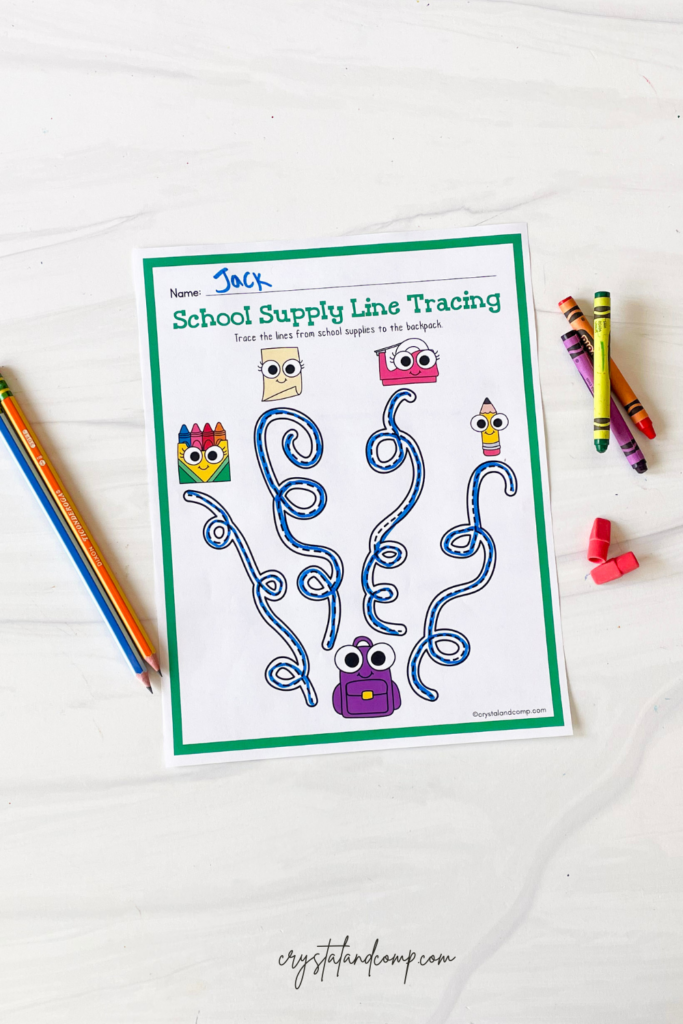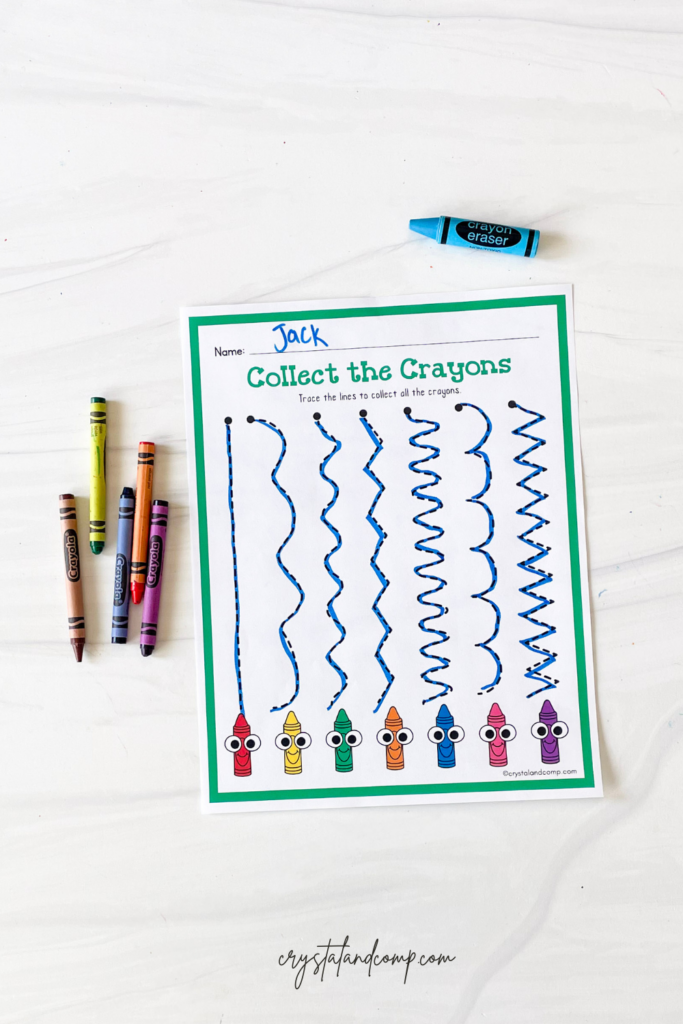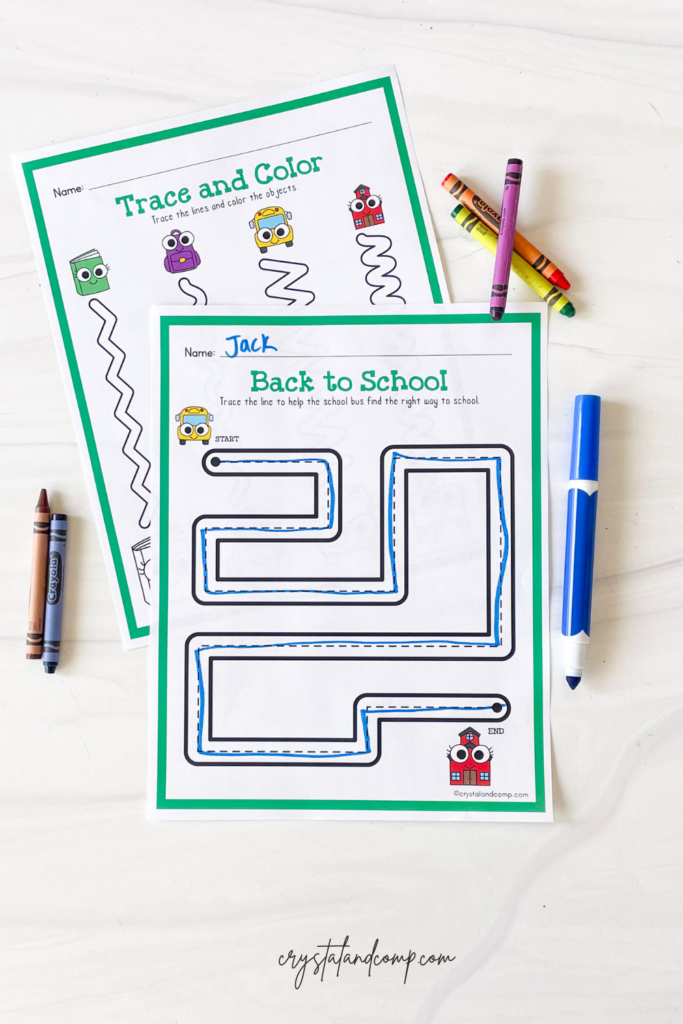Back to School Line Tracing Printables
As the summer comes to an end, many parents and educators alike are gearing up for the upcoming school year. Getting back into the swing of things can be a bit overwhelming, but there are plenty of resources available to make the transition easier. One such resource is a set of fun and educational Back to School Line Tracing Printables. Designed with young learners in mind, these printables offer a variety of tracing exercises to help develop fine motor skills and hand-eye coordination.
Whether used in a classroom setting or at home, Preschool Handwriting Practice is a great way to engage kids in learning while having fun at the same time. So why not give them a try and start the school year off on the right foot!

These line tracing printables can offer a multitude of benefits for parents and educators alike. Not only do they provide a fun and educational activity for kids, they also offer valuable insight into a child’s motor skills and can help them build important cognitive abilities as they begin the new school year. So, if you’re looking for a simple yet effective way to prepare for the upcoming school year, these printables are a great place to start!
JOLLY X-Big Jumbo Colored Pencils; Set of 12, Perfect for Special Needs, Art Therapy, Pre-School and Early Learners, Multicolor (3099-0001)LovesTown Preschool Training Scissors,6 Pcs Dual-Colour Children Safety Scissors Pre-School Training Scissors Safety Scissors Art Craft Scissors
Channie’s My First Pencil, Easy-to-Hold Write Size Graphite Jumbo Barrel Presharpened Wooden 2B Small Pencils for 3-7 Year Olds, White Color, 2 Pack (5 Pencils Each)
HP OfficeJet Pro 8025e Wireless Color All-in-One Printer with bonus 6 free months Instant Ink with HP+ (1K7K3A), Gray
HP Paper Printer | 8.5 x 11 Paper | Premium 32 lb | 1 Ream – 500 Sheets | 100 Bright | Made in USA – FSC Certified | 113100R
Crayola Large Crayons – Assorted (8 Count), Giant Crayons for Kids & Toddlers, Ages 2+
How Does Tracing Help Fine Motor Skills?
Tracing is an activity that involves outlining shapes or images by following lines or edges. This may seem like a simple task, but it is actually an excellent exercise for developing fine motor skills in children and adults alike. The act of tracing requires hand-eye coordination, spatial awareness, and a steady hand. These skills are essential for everyday tasks such as writing, typing, and drawing. When we trace, we are essentially training our hands and fingers to perform precise movements, which can significantly enhance our fine motor skills.

Tracing is an effective way to improve fine motor skills because it helps to build muscle memory. When we repeat a tracing activity over and over, we are reinforcing the neural connections between our brains and our hands. This means that our hands become more adept at performing the precise movements required for tracing, and this skill can then be transferred to other activities. In addition to building muscle memory, tracing can also help to improve hand-eye coordination. This is because tracing requires us to focus on a particular image or shape while simultaneously guiding our hands to follow the lines.
Tracing can help to develop spatial awareness. This is because tracing requires us to understand the relationships between different shapes and lines, and to visualize how they fit together. Tracing is an excellent way to improve fine motor skills, and it is a fun and engaging activity for people of all ages.
Scroll To The Bottom To Download!
What Are The Benefits Of Number Matching Activities?
Number matching activities are an excellent tool for learning numbers and enhancing numeracy skills. The benefits of these activities are multifaceted and have been extensively researched. Firstly, number matching activities help in developing number sense and understanding how numbers relate to one another. These activities enable children to recognize numbers and count confidently. They also help in building basic arithmetic skills that are essential for solving complex problems in the future.

Improvement in hand-eye coordination is another benefit of number matching activities. As children place numbers in the correct order, they develop fine motor skills, which helps improve hand-eye coordination. These activities can make children more focused and attentive. When children are actively engaged in these activities, it stimulates their brain and improves their concentration and attention span. This, in turn, not only helps them academically but can also enhance their ability to be present and engaged in any task they undertake.
Number matching activities can promote teamwork, social skills, and cognitive development in children, all of which are instrumental for their overall development. Number matching activities are an excellent and fun way to boost children’s cognitive development and improve their numeracy skills through interactive play.
What Are The Benefits Of Tracing Lines?
Tracing lines is an activity that seems simple and mundane, but the benefits it can bring to young children are significant. One of the most evident benefits of tracing lines is that the activity promotes the development of fine motor skills. Fine motor skills are essential for young children as they enable them to perform everyday tasks such as holding a pencil, cutting paper, or buttoning a shirt.
Tracing lines allows children to practice and strengthen the small muscles in their hands, fingers, and wrists, which are necessary for these activities. Fine motor skills also support the child’s cognitive and emotional development. By improving a child’s manual dexterity, we enhance their ability to focus, concentrate, and express themselves creatively, ultimately contributing to their confidence and self-esteem.

Another benefit of tracing lines is that it enhances a child’s visual-motor integration skills. Visual-motor integration is a term used to describe the coordination between the visual and motor systems of the body. Tracing lines helps to build a bridge between the two systems by requiring children to follow visual cues while performing a motor task. This activity can be especially beneficial for children who are struggling to learn to read and write. Tracing lines develops essential skills such as hand-eye coordination, spatial orientation, and visual perception, which are instrumental in successfully decoding and comprehending written text.
Tracing Printables For Preschoolers
Tracing printables have become an essential tool for preschoolers’ learning, specifically when it comes to improved handwriting skills. Children at this age typically have underdeveloped fine motor skills and may have trouble grasping a pencil, controlling its movements, and drawing precise lines and shapes.
- Shark Line Tracing Printables
- Ice Cream Line Tracing Printables
- The Very Hungry Caterpillar Line Tracing Printables
- Seashell Preschool Printables
Is Using Scissors For Cutting Traceable Lines Beneficial For Preschoolers?
Using scissors for cutting traceable lines can be a great way to promote fine motor skills development in preschoolers. Not only does cutting help to improve their hand-eye coordination, but it also strengthens the muscles in their hands that are necessary for tasks such as writing, drawing, and even typing later in life. However, it is important to note that while cutting with scissors can be a beneficial activity, it is crucial that preschoolers are supervised and taught proper scissor safety techniques to avoid any potential accidents.
Cutting traceable lines can also aid in the development of children’s visual-spatial skills. By following the lines, preschoolers are able to practice both their spatial awareness and hand movements, which are vital for later activities such as tying shoes, buttoning clothes, and using utensils. Cutting can support preschoolers’ creativity as they begin to experiment with different patterned lines and shapes. It provides an opportunity for them to express themselves and develop their own unique artistic abilities. While using scissors for cutting traceable lines may seem like a simple activity, it offers numerous benefits for preschoolers’ cognitive, fine motor, and creative development.

Printables provide an excellent opportunity for preschoolers to learn fundamental concepts in math and literacy. Children learn to recognize letters and numbers, practice tracing and writing them. They also learn to count, identify shapes and colors, which lay the groundwork for advanced math concepts. Worksheets foster creativity, as children get to fill in pictures, connect dots, and complete mazes. As children progress, they develop critical thinking skills, as they get to solve puzzles and think critically to complete exercises. Worksheets are an effective teaching tool in a preschool curriculum, as they help children to learn essential concepts in a fun and engaging way.
Matching Activities For Preschoolers
Matching activities are an excellent way to help preschoolers develop their cognitive and memory skills. These activities are simple yet effective, allowing young children to identify similarities and differences between objects, shapes, colors, and more.
- Ocean Preschool Printables
- Letter Matching Worksheets
- Apple Math Color Matching Game
- Ice Cream Matching Game
- Alphabet Letter Matching Game
Why Is Pencil Grip Important For Preschoolers?
Pencil grip is an essential skill for preschoolers to learn. It involves holding a pencil or crayon in a proper way so that they can write or draw with ease. Developing a good pencil grip impacts a child’s handwriting, motor skills, and cognitive development.
A correct pencil grip helps children to develop strong fine motor skills, an essential aspect of their cognitive development. Fine motor skills require the coordinated effort of small muscles in the hands and fingers, which helps in developing dexterity, hand-eye coordination, and finger strength. Improving fine motor skills will also help preschoolers build up their handwriting skills, which is essential for communication, and following instructions.

As the school year begins anew, it’s the perfect time to sharpen your child’s fine motor skills with these back to school line tracing printables. These free, easy-to-use printables are a great way to introduce little learners to writing and drawing. Tracing lines helps your child develop hand-eye coordination, spatial awareness, and builds the foundation for more complex skills like writing. Once your child has mastered the lines, they can move onto tracing letters, numbers, and shapes. With these back to school line tracing printables, your child will be ready to take on the school year with confidence and ease!







Thank you
Thanks
You are very welcome. Hope your kiddos love the handwriting practice.